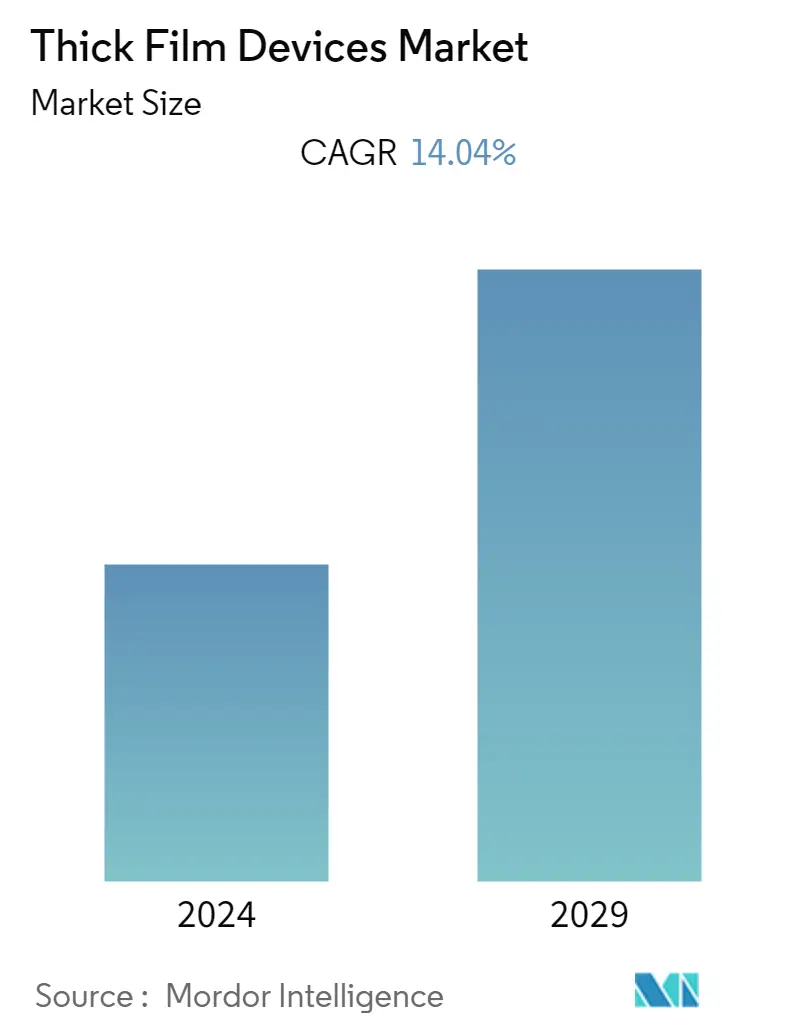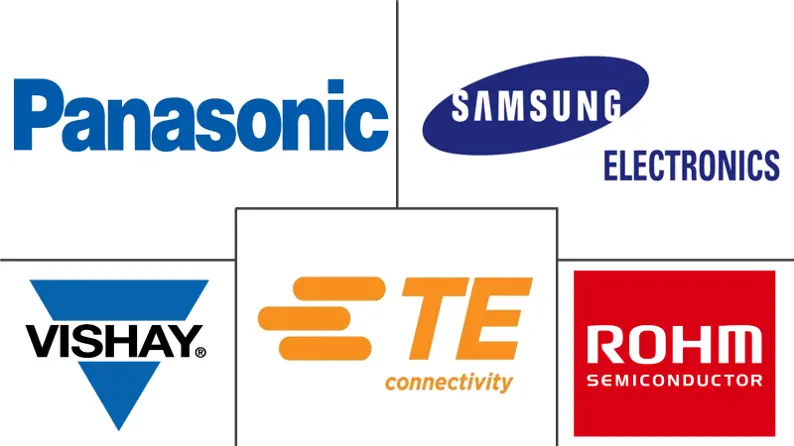Market Size of Thick Film Devices Industry

| Study Period | 2019 - 2029 |
| Base Year For Estimation | 2023 |
| CAGR | 14.04 % |
| Fastest Growing Market | Asia Pacific |
| Largest Market | Asia Pacific |
| Market Concentration | High |
Major Players
*Disclaimer: Major Players sorted in no particular order |
Thick Film Devices Market Analysis
The thick film devices market has registered a CAGR of 14.04% over the forecast period 2021 to 2026 to reach USD 177.13 billion by 2025. The global thick film devices market is expected to grow significantly over the forecast period. This is due to increasing adoption in the manufacturing process of the electrical and electronic devices and surge in demand for advanced miniature tools. Rapid heat-up and thermal cycling, precise temperature control, low energy consumption, and portable applications are some significant characteristics of the studied technology, which are gaining adoption over other technologies.
- For instance, in April 2020, Bourns, Inc. announced the availability of a new AEC-Q200 compliant series of thick film chip resistors -- Model CRxxxxA series. It is designed in five different versions to support specific application requirements -- CR standard, CR-PF ultra-low lead content, CR-AS sulfur resistant, CRxxxxA-AS AEC-Q200 compliant, and sulfur resistant and CRxxxxA AEC-Q200 compliant. In May 2019, ATE Electronics had released the next power level thick film resistor PR800. This new resistor has a 30% higher power capability than the latest PR600 with the same footprint of 57(65) x 60mm.
- The growing technological advancements in the sector is also expanding thick film devices' industrial adoption. Growing demand for MEMS (microelectromechanical systems) and multi-layer ceramic capacitors are also expected to fuel the demand for thick film technology over the forecast period. However, in 2019, thick film chip resistor and MLCC manufacturers experienced price increases in feedstock metals, which is also a capable passive component industry. It is estimated that variable costs to produce MLCC and thick film chip resistors (which are the two-mass produced passive components) amount to about 70-80% of the cost of goods sold in various passive electronic component industries.
- Increasingly demanding technical requirements have exposed the limits of the standard thick-film technologies used to produce circuit-board conductors. However, companies are also investing in developing a new generation of thick-film pastes, and their photolithographic structuring enables the manufacturing of extremely high-resolution thick-film structures necessary for advanced applications, like 5G technology.
- For instance, researchers from the Fraunhofer Institute for Ceramic Technologies and Systems IKTS, in collaboration with MOZAIK, a UK-based company, have developed conductors based on screen-printing technology with a resolution of 20 micrometers or less. They claim that the process is suitable for industrial applications (especially 5G) and mass production, and the investment costs are low.
- The spread of the novel Corona Virus has severely affected the market studied. This is because of the sudden shutdown of factories along with a ban on international flights. In modern manufacturing history, demand, supply, and workforce availability for the first time are affected globally at the same time. Thick film devices manufacturing requires people to be physically on-site. Most of the factories making these devices are not designed to be managed remotely. February 2020 also witnessed the biggest-ever fall in the history of the worldwide smartphone market. Due to the dampened sales of these durables, the market vendors' operating profit has drastically decreased.
Thick Film Devices Industry Segmentation
Thick film devices are single-layered or multi-layered structures that are made up by the deposition of a formulated paste on a substrate. The substrate is made of different materials such as ceramic, polymer, and metals. The layer deposited on the substrate facilitates mechanical, electrical, and chemical functionality for the device, in which the coating is fabricated. Thick film devices are widely used in energy devices such as photovoltaic cells and fuel cells as well as in electronic devices such as capacitors and circuit devices. Moreover, the thick film devices find their use in mechanical and chemical apparatus, which consist of optical sensors and piezoelectric devices.
| By Type | |
| Capacitors | |
| Resistors | |
| Photovoltaic cells | |
| Heaters | |
| Other Types |
| By End-user Industry | |
| Automotive | |
| Healthcare | |
| Consumer Electronics | |
| Infrastructure | |
| Other End-user Industries |
| Geography | |
| North America | |
| Europe | |
| Asia-Pacific | |
| Rest of the World |
Thick Film Devices Market Size Summary
The thick film devices market is poised for substantial growth, driven by the increasing integration of these devices in electrical and electronic manufacturing processes and the rising demand for advanced miniature tools. The technology's attributes, such as rapid heat-up, precise temperature control, low energy consumption, and portability, are contributing to its preference over alternative technologies. The market is witnessing significant advancements, with companies like Bourns, Inc. and ATE Electronics introducing new product lines to meet specific application requirements. The sector's expansion is further fueled by the growing demand for microelectromechanical systems (MEMS) and multi-layer ceramic capacitors. However, the market faces challenges, including price increases in feedstock metals and the need for new generations of thick-film pastes to meet demanding technical requirements, particularly in advanced applications like 5G technology.
The Asia-Pacific region emerges as a critical hub for the thick film devices market, supported by favorable government policies and its status as a leading producer of consumer electronics. The region's semiconductor industry expansion and the increasing adoption of MEMS across various sectors are bolstering market demand. Despite the pandemic's impact on operations and sales, particularly in the automotive and consumer electronics sectors, the market remains consolidated with major players like Panasonic Corporation, Samsung Electronics Co. Ltd, and Vishay Intertechnology Inc. dominating the landscape. These companies continue to innovate, introducing products designed for harsh environments and high power applications, thereby maintaining their competitive edge in the market.
Thick Film Devices Market Size - Table of Contents
-
1. MARKET INSIGHTS
-
1.1 Market Overview
-
1.2 Industry Attractiveness - Porter's Five Force Analysis
-
1.2.1 Bargaining Power of Suppliers
-
1.2.2 Bargaining Power of Consumers
-
1.2.3 Threat of New Entrants
-
1.2.4 Threat of Substitute Products
-
1.2.5 Intensity of Competitive Rivalry
-
-
1.3 Industry Value Chain Analysis
-
-
2. MARKET SEGMENTATION
-
2.1 By Type
-
2.1.1 Capacitors
-
2.1.2 Resistors
-
2.1.3 Photovoltaic cells
-
2.1.4 Heaters
-
2.1.5 Other Types
-
-
2.2 By End-user Industry
-
2.2.1 Automotive
-
2.2.2 Healthcare
-
2.2.3 Consumer Electronics
-
2.2.4 Infrastructure
-
2.2.5 Other End-user Industries
-
-
2.3 Geography
-
2.3.1 North America
-
2.3.2 Europe
-
2.3.3 Asia-Pacific
-
2.3.4 Rest of the World
-
-
Thick Film Devices Market Size FAQs
What is the current Thick Film Devices Market size?
The Thick Film Devices Market is projected to register a CAGR of 14.04% during the forecast period (2024-2029)
Who are the key players in Thick Film Devices Market?
Panasonic Corporation, Samsung Electronics Co. Ltd, TE Connectivity Ltd, Vishay Intertechnology Inc. and Rohm Semiconductor GmbH are the major companies operating in the Thick Film Devices Market.

